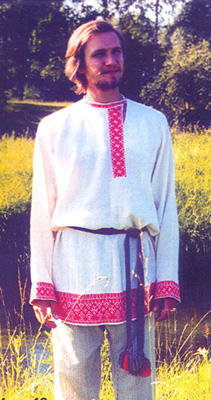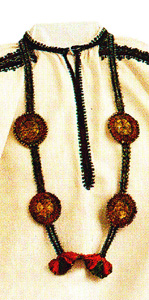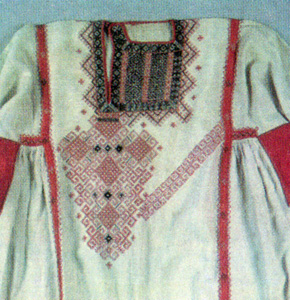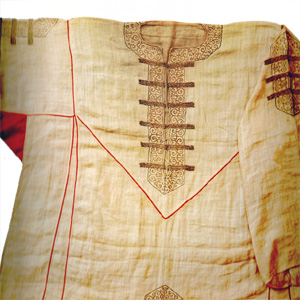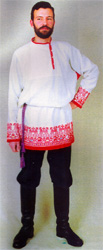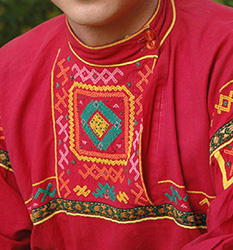
| Outfits >>> Read about… >>> Man's shirt. | ||||||||||||||||
|
The Russian word for a shirt (rubaha - roo-BAH-khah) is derived from ancient Slavic word rub - rOOb - a piece of cloth. For many centuries a shirt was the main clothing for both noble people and peasants. It became "just a village costume" in the 18th century, after (and because) political, cultural, and economical changes made by Peter the Great.
A chiton-like design is the most ancient. Also, it is the most common for Slavic and Russian shirts. The cut is: a rectangular piece of cloth is folded half-by-half across a warp (along a woof). On the fold line they make an oval hole for a neck, and a long cut on a front part of a shirt. It was the base form of a shirt. Later, bochki - sides (additional pieces of cloth - rectangular or more fancy-shaped) appeared by sides of a stanushka - a body of a shirt. Sleeves are wrist-long. The most ancient sleeves were just strait, with no any cuffs. In certain parts of Russia and (especially) Siberia scientists found shirts with sleeves strong-folded near shoulders. Sleeves with cuffs are very rare in Russia. To let arms move freely, Russian shirts have lastovica - rectangular armpit details to connect a body of a shirt and a sleeve. Mostly, they are red. Men's shirts can have a small collar, or they can have no collar at all. And, (last but not least) a man's shirt must have a podopleka - a chest-long lining. It could be made of the same cloth as a shirt itself, but rich people made it of any expensive and fancy fabric, to show-off their wealth. Men wore their shirts outside pants, with a fancy woven belt, or with a leather strap. It is important to say that in ancient times they have made a chest cut right in the middle of a front part of a shirt. According to an archaeological data, shirts with a cut on the left (or sometimes on the right) side (so-called kosovorotka) appeared not earlier than the 16th century, and as a peasants' design only. Noble people wore shirts with a middle cut, until the 18th century (the end of a traditional clothing style for aristocracy in Russia). However, a middle cut was kept for ritual shirts (wedding or funeral ones) until the beginning of the 20th century.It is a common tendency for a traditional clothes: an everyday costume of the former epoch becomes a ritual outfit in the latter times.
Scientists think that a side cut is special for Russian shirts only (no such shirts of other Slavic people have been found). Commonly, a chest cut was made on the left side. But, sometimes it could be on the right. There is no any rule of it (we cannot say "the right cut is for certain age group or for certain region of Russia"). We guess it just depended on a wearer: if he was right-handed or left-handed). However, in regions where they make a side cut even on wedding shirts, the ritual embroidery is shifted too, to keep its symmetry against the cut. Scientists believe that the cut and embroidery were centered in earlier times.
Farmers made their shirts of home-woven linen of hemp. Everyday work shirts were creamy-white or motley (a motley cloth was made of threads of different colors and matter - i.e., a warp was woolen, and a woof was made of hemp). A difference in colors of shirts was noticed by scientists from the 14th century. Young bachelors wore red shirts in addition to white and motley. Heads of a family, and seniors of a so-called "the first age of seniority" (50-65 years of age) wore dark-blue shirts. Seniors of "the second age of seniority" (after 70 years of age) were allowed to wear black and brown. A noble man's shirt usually was made of an expensive silk or a brocade, or of a bleached "two-year-made" linen. A center cut was fastened with a fancy golden, silver, or pearl button. In contrast to village shirts, those for rich men were extremely long: knee- or mid-calf-long. It has been made to show-off: look, how rich I am, I even could afford extra brocade just for a shirt. At 1700s, people started to use cloth decorated with home-made printed designs. And, from the beginning of the 19th century, a manufactory-made cloth became affordable for village people. So, people used such an expensive fabric for festive outfits. They decorated their fancy shirts with a complex embroidery, golden trim, and appliquees of silk and brocade. Starting from 1400s, rich farmers (especially in Siberia and Altai mountains, which are not far from China) could afford silken shirts. For sure, such shirts were counted as an asset, and they were kept carefully and passed from generation to generation.
A man's shirt must carry talismans around a neck, wrists, and at the bottom. At least, it should be a red "fire-line". Embroidered or appliquee sacred designs worked much better. In the 18th century, one more spiritual protecting element was invented: a "shield". First, it appeared in Siberia. Then it moved to European part of Russia. A "shield" is a rectangular piece of cloth, bearing sacred symbols of protection (or, at least, just a piece of a red cloth). A shield is placed around or along a front cut.
| ||||||||||||||||
Sources (in Russian)
|
